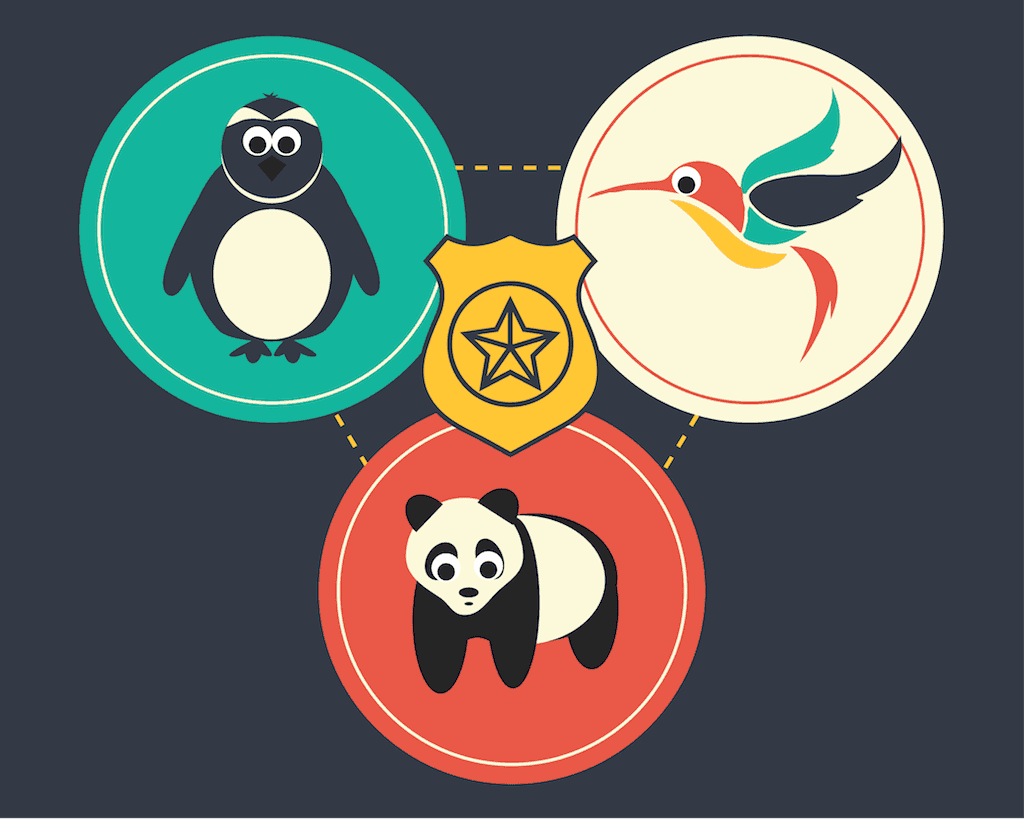3 Google Algorithms That Will Make or Break Your Site Rank

Penguin. Panda. Hummingbird. No, we’re not talking about the latest exhibitions at the zoo. We’re talking about Google’s search result ranking algorithms that crawl your web pages in order to rank them.
These algorithms are sort of like recipes that Google uses to sort through and rank trillions of web pages in the search engine. But don’t be fooled by the chummy animal-themed codenames — these algorithms are basically like the SEO police, and how these algorithms view your website can boost or destroy your web traffic.
Understanding Google’s SEO Police
Search engine optimization is all about streamlining a user’s journey through the web. Through SEO, we strive to increase organic traffic by making it easier for visitors to find webpages and encouraging them to click through superb content — and Google algorithms are blueprints for crafting a website that does just that.
That’s why understanding how these algorithms reward or punish a website is crucial for strategizing a website’s SEO. So without further ado, let’s bite down on our snorkels and take a deep dive into the Penguin, Panda and Hummingbird algorithms.
1) Penguin
The primary purpose of this little guy is to assess a site’s link health. In particular, the Penguin algorithm recognizes and punishes spammy pages that achieve high rankings by buying spam links or through a network of low-quality links.
Legitimate links to and from your site are great indicators of a healthy page. Good internal and external links show that your content is relevant and informative in a way that encourages visitors to navigate from site to site. Broken links or links to spammy sites, on the other hand, disrupts a user’s navigation experience.
To up your link game and be on Penguin’s good side, you can:
- Check your pages for broken links.
- Disavow backlinks from spammy or faulty websites.
- Optimize for content by creating strong copy anchored on important keywords related to your services/product.
If you want to learn more about healthy link building, check out our post on how to create great internal links and how to clean up faulty backlinks.
To keep up with the latest version of Penguin, check out how to prep your website for the latest Google Penguin update.
2) Panda
This algorithm specializes in scoring sites for content quality by looking for pages with thin content or content farms.
You’ve probably seen content farms — those 3,000-word pages chock-full of incoherent mess of keywords and anchor texts without relevant content. Thin content, on the other hand, refers to pages full of keywords and copy but light on any real information, like a website consisting of two entire pages with a couple lines of keyword-stuffed text.
Sites like these existed purely for the purpose of higher search result visibility, and they worked — until Panda came along. The primary purpose of Panda is to rank sites with quality content higher in the results page, while penalizing spammy sites that just repeat keywords over and over again.
In order to avoid thin content and score high with Panda, you can:
- Create multiple pages and categories for your website so you can upload content on a regular basis. Blogs are the easiest way to do this!
- Create informative content with carefully researched keywords through SEO copywriting.
- Optimize for click through by rewriting title tags, meta descriptions, etc.
To keep up with the latest version of Panda, check out this article on the Panda 4.0 update.
3) Hummingbird
This most recent addition to Google’s arsenal of ranking algorithm is perhaps Google’s most powerful feature: semantic search.
Instead of focusing on each individual word in the search query, the Hummingbird update allows Google to leverage natural language — or semantic search — to account for synonyms, variations and context. This added contextualization means Google searches can now take into account the whole sentence or meaning of a search query, not just specific keywords, in order to return more accurate and personalized results.
To take full advantage of Hummingbird’s search algorithm, you can:
- Optimize for informative, relevant and non-spammy content that is important for your readers.
- Diversify the length of your content and use lots of visual content.
- Use topic-appropriate language such as industry-specific terminology.
Content Really Is King
It’s no news that good content trumps all in the world of SEO, and lo and behold, a key commonality among the various Google algorithms is that they revolve heavily around assessing your site’s content.
The best way to optimize your website for good ranking and increase organic traffic to your site is creating readable, informative and relevant content that speaks to your visitors and potential customers.
Because as much as you can forcibly increase your domain authority by buying spammy links and stuffing keywords, you won’t be attracting the visitors that really matter. What makes the difference is fantastic original content that makes visitors want to stay a few seconds more and click through a couple more tabs.
__
Hungry for more info on Google algorithms? Check out this blog about recent Google algorithm changes.
Which algorithm do you think your site needs to optimize for the most? Comment in the section below, email us at info@perfectsearchmedia.com or tweet us @Perfect_Search!
